

Boston Dynamics: Dedicated to the Science and Art of How Things Move.
Group project. Why We Help: The Evolution of Cooperation. Last april, as reactors at japan's fukushima daiichi nuclear power plant were melting down following a lethal earthquake and tsunami, a maintenance worker in his 20s was among those who volunteered to reenter the plant to try to help bring things back under control.
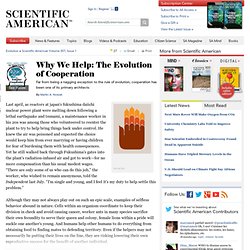
University: Research News @ Tufts. Exploring the Thought Bubble. Robots @ tufts. Teaching Robots the Complexities of Human Social Interactions Matthias Scheutz, PhD, joined the Department of Computer Science in 2010.
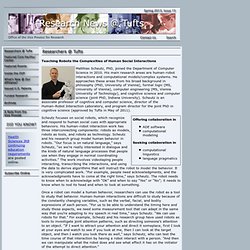
His main research areas are human–robot interactions and computational models/complex systems. He approaches these areas from his broad background in philosophy (PhD, University of Vienna), formal logic (MS, University of Vienna), computer engineering (MS, Vienna University of Technology), and cognitive science and computer science (joint PhD, Indiana University). Scheutz is an associate professor of cognitive and computer science, director of the Human–Robot Interaction Laboratory, and program director for the joint PhD in cognitive science (approved by Tufts in May of 2011). Media Lab: Affective Computing Group. On the Trail of the Higgs Boson. Scientists at CERN, a multinational research center based in Geneva, Switzerland, announced on July 4 that they had found a new elementary subatomic particle that has properties consistent with the hypothesized Higgs boson, which supposedly gives mass to all other particles.
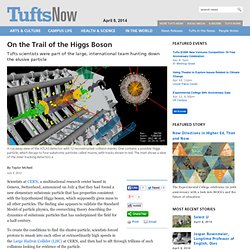
The finding also appears to validate the Standard Model of particle physics, the overarching theory describing the dynamics of subatomic particles that has underpinned the field for a half-century. To create the conditions to find the elusive particle, scientists forced protons to smash into each other at extraordinarily high speeds in the Large Hadron Collider (LHC) at CERN, and then had to sift through trillions of such collisions looking for evidence of the particle. Helping hunt for the Higgs. What, exactly, is a Higgs boson? Fundamentally speaking, explained Melissa Franklin, Physics Department chair and Mallinckrodt Professor of Physics, the Higgs boson is a subatomic particle, one of more than a dozen such particles, including quarks, electrons, muons, and neutrinos.
This particle, however, is unique because its discovery acts as confirmation of the existence of the Higgs field. In the Beginning Was the Beginning. By now, there’s scientific consensus that our universe exploded into existence almost 14 billion years ago in an event known as the Big Bang.
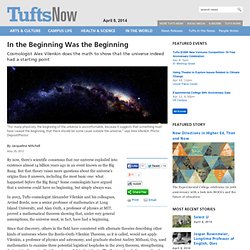
A Different Kind of Secret Code. Researchers have invented a new form of secret messaging using bacteria that make glowing proteins only under certain conditions.
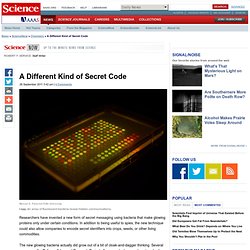
In addition to being useful to spies, the new technique could also allow companies to encode secret identifiers into crops, seeds, or other living commodities. The new glowing bacteria actually did grow out of a bit of cloak-and-dagger thinking. Several years ago, the Defense Advanced Research Projects Agency asked researchers to submit ideas for ways to encode secret messages without the need for electronics. Physicists Slow Speed of Light. Physicists Slow Speed of Light By William J.
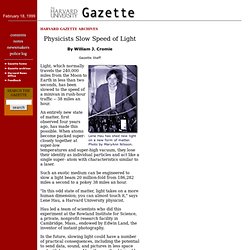
Personal Genome Project - Homepage. A Reality Check for Personal Genomes. CHICAGO—Biomedical researchers talk about the day not too far off when DNA sequencing will be so cheap that everyone will have their genome sequenced and carry the results around on a flash drive.

People will learn about their personal disease risks, helping their doctors and them prevent or treat these illnesses. But a new study throws cold water on the notion that whole-genome sequencing will be very useful for the average person. Hopes for genomic medicine have grown in the past few years as researchers raced to track down DNA behind common diseases. These so-called genome-wide association studies have turned up hundreds of genetic markers linked to diseases such as cancer and diabetes. LMM Research. The Laboratory for Molecular Medicine (LMM) supports several research studies that are ongoing within the laboratory or in affiliation with other clinical research groups.
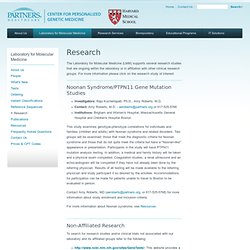
For more information please click on the research study of interest. Noonan Syndrome/PTPN11 Gene Mutation Studies Investigators: Raju Kucherlapati, Ph.D., Amy Roberts, M.D.Contact: Amy Roberts, M.D. - aeroberts@partners.org or 617-525-5768Institutions: Brigham and Women's Hospital, Massachusetts General Hospital and Children's Hospital Boston. Science News Headlines from ScienceNOW- The latest news from the science world. A Breath of Fresh Microbubbles. John Kheir knows what it's like to lose a race against time with oxygen.

In October 2006, the pediatric critical care doctor was treating a 9-month-old girl admitted to Boston Children's Hospital with viral pneumonia. As her disease worsened, her lungs hemorrhaged, filling with blood and blocking her breathing. Kheir jumped into action, shoving a breathing tube down her windpipe to help get air to her lungs, performing CPR, and eventually putting the baby on a machine that took over for her heart and lungs. But in the minutes it took to restore the flow of air into the young girl's body, her brain had already suffered permanent damage because of the lack of oxygen. She died a few days later. Devastated, Kheir began looking for better ways to get oxygen into the body.
Study of the Day: An Incredible New Way to Breathe During an Emergency - Hans Villarica. A single intravenous injection of a lipid-based gas-filled solution brought 15 minutes worth of life-saving oxygen to rabbits with completely blocked airways.

An injected oxygen microparticle encounters a red blood cell deprived of this vital gas. A Shotgun for Blood Clots. New virus-built battery could power cars, electronic devices.